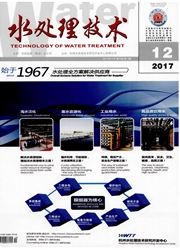

 中文摘要:
中文摘要:
将城市污水二级出水中溶解性有机物分为强疏水性、弱疏水性和亲水性纽分,研究其对超滤膜的污染。测定结果表明,二级出水中有机物对膜污染影响程度顺序为:强疏水性有机物〉亲水性有机物〉弱疏水性有机物。究其原因:(1)膜污染与有机物分子量大小有关,膜选择性地截留强疏水性有机物主要是这类有机物分子量较大所致。(2)从三维荧光光谱图上看,3个组分中均含有腐殖酸类荧光峰,说明腐殖酸类物质对膜通量的衰减贡献最大。(3)强疏水性组分中所含有机物最为复杂,荧光峰最为明显,由此可见膜污染的程度不仅与组分中所含有机物的种类有关,而且与其含量有关。此外,膜被有机物污染的程度与膜对有机物的去除率有着密切的关系。总荧光强度(FLU)可作为总有机物含量的一种指标来反映有机物被膜截留的情况。
 英文摘要:
英文摘要:
Dissolved organic matters of Secondary Effluent of urban wastewater were divided into strongly hydrophobic, weakly hydrophobic and hydrophilic fractions. And the effects of the three fractions on fouling extent of ultrafiltration membrane were investigated. It demonstrated that the order of membrane fouling caused by dissloved organic matters of effluent was strongly hydrophobic〉 hydrophilic fractions〉 weakly hydrophobic. The reasons were that (1) membrane fouling was related with molecular weight. Strongly hydrophobic constituent retained by membrane was due to its higher molecule weight. (2)There were humic acid fluorescence peaks in these three fractions from the three-dimensional fluorescence spectrum. It indicated that humic acid had the largest contribution to the reduction of membrane flux. (3) Strongly hydrophobic constituent was the most complex, and fluorescence peak was the most obvious. This showed the extent of membrane fouling was related with the kind of organic matters and the content of that. In addition, membrane fouling was concerned with the removal rate of organic matters by membrane intimately. FLU may conduct as a index to response organic matters retained by membrane.
 同期刊论文项目
同期刊论文项目
 同项目期刊论文
同项目期刊论文
 Preparation of PVDF membranes via the low-temperature TIPS method with diluent mixtures: The role of
Preparation of PVDF membranes via the low-temperature TIPS method with diluent mixtures: The role of Understanding PVDF ultrafiltration membrane fouling behavior through model solutions and secondary w
Understanding PVDF ultrafiltration membrane fouling behavior through model solutions and secondary w Preparation of PVDF hollow fiber ultrafiltration membrane via phase inversion/chemical treatment met
Preparation of PVDF hollow fiber ultrafiltration membrane via phase inversion/chemical treatment met Study on the effect of modified PVDF ultrafiltration membrane for secondary effluent of urban sewage
Study on the effect of modified PVDF ultrafiltration membrane for secondary effluent of urban sewage The effect of PVDF concentration on PVDF/woven tube composite membranes and the application of compo
The effect of PVDF concentration on PVDF/woven tube composite membranes and the application of compo ExperimentalStudy of Adhesion Properties Between Membrane Surface and Humic Acid DuringMicrofiltrati
ExperimentalStudy of Adhesion Properties Between Membrane Surface and Humic Acid DuringMicrofiltrati Mechanism analysis of membrane fouling behavior by humic acid usingatomic force microscopy: Effect o
Mechanism analysis of membrane fouling behavior by humic acid usingatomic force microscopy: Effect o Polyvinylidene fluoride/poly(ethylene-co-vinyl alcohol) blended membranes and a systematicinsight in
Polyvinylidene fluoride/poly(ethylene-co-vinyl alcohol) blended membranes and a systematicinsight in Enhancement and Mitigation Mechanisms of Protein Fouling of Ultrafiltration Membranes underDifferent
Enhancement and Mitigation Mechanisms of Protein Fouling of Ultrafiltration Membranes underDifferent Preparation of a polyvinylidene fluoride membrane material probe and its application in membrane fou
Preparation of a polyvinylidene fluoride membrane material probe and its application in membrane fou Study of antifouling modified ultrafiltration membrane based on the secondary treated water of urban
Study of antifouling modified ultrafiltration membrane based on the secondary treated water of urban 期刊信息
期刊信息
